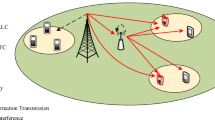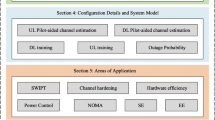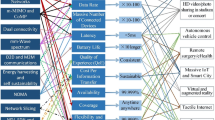Abstract
Non-orthogonal multiple access (NOMA) scheme, potentially enabling high spectral efficiency, is one of the key technological innovations in the 5th generation (5G) cellular networks. The massive machine type communications (mMTC) service category of 5G supports ultra-dense deployment of connected devices with low-power and low data-rate requirements, and so it naturally supports internet-of-things (IoT) communications. Also, the ambient backscatter communications (BsC) holds potential for enabling energy-constrained IoT communications due to its extremely low power requirements. This work analyzes the downlink of a NOMA-enabled cellular system bundled with symbiotic radio-based mMTC. Closed-form expressions of the outage probability for the signal-to-interference and noise ratio (SINR) and the ergodic rate are derived for the symbiotic radio backscatter device as well as the primary cellular user. Several interesting use-cases of the proposed system model are discussed for future massive IoT and cell-free networks. The theoretical results presented are validated through numerical evaluations.










Similar content being viewed by others
References
International Telecommunication Union. (ITU). (2015). IMT traffic estimates for the years 2020 to 2030. Report ITU-R M. 2370-0, ITU-R Radiocommunication Sector of ITU.
Anwar, A., Seet, B.-C., & Ding, Z. (2018). Non-orthogonal multiple access for ubiquitous wireless sensor networks. Sensors, 18(2), 516.
Islam, S. M. R., Avazov, N., Dobre, O. A., & Kwak, K. (2017). Power-domain non-orthogonal multiple access (NOMA) in 5G systems: Potentials and challenges. IEEE Communications Surveys Tutorials, 19(2), 721–742.
Benjebbour, A., Saito, Y., Kishiyama, Y., Li, A., Harada, A., & Nakamura, T. (2013). Concept and practical considerations of non-orthogonal multiple access (NOMA) for future radio access. In: International symposium on intelligent signal processing and communication systems (pp. 770–774).
Technical Specification Group Services and Systems Aspects. (2018). System Architecture for the 5G System; Stage 2, Releases 15, 3GPP. Tech. Rep. document 3GPP TS Jun., 23(501), V15.2.0.
Nawaz, S. J., Sharma, S. K., Wyne, S., Patwary, M. N., & Asaduzzaman, M. (2019). uantum machine learning for 6G communication networks: State-of-the-art and vision for the future. IEEE Access, 7, 46317–46350.
Patwary, M. N., Nawaz, S. J., Rahman, M. A., Sharma, S. K., Rashid, M. M., & Barnes, S. J. (2020). The potential short- and long-term disruptions and transformative impacts of 5G and beyond wireless networks: Lessons learnt from the development of a 5G testbed environment. IEEE Access, 8, 11352–11379.
Nawaz, S. J., Sharma, S. K., Mansoor, B., Patwary, M. N., & Khan, N. M. (2021). Non-coherent and backscatter communications: Enabling ultra-massive connectivity in 6G wireless networks. IEEE Access, 9, 38144–38186.
Lyu, B., Yang, Z., Gui, G., & Sari, H. (2017). Optimal time allocation in backscatter assisted wireless powered communication networks. Sensors, 17(6), 1258.
Stockman, H. (1948). Communication by means of reflected power. Proceedings of the IRE, 36(10), 1196–1204.
Long, R., Liang, Y., Guo, H., Yang, G., & Zhang, R. (2020). Symbiotic radio: A new communication paradigm for passive internet of things. IEEE Internet of Things Journal, 7(2), 1350–1363.
Yang, Z., Ding, Z., Fan, P., & Karagiannidis, G. K. (2015). On the performance of non-orthogonal multiple access systems with partial channel information. IEEE Transactions on Communications, 64(2), 654–667.
Saito, Y., Benjebbour, A., Kishiyama, Y., & Nakamura, T. (2013). System-level performance evaluation of downlink non-orthogonal multiple access (NOMA). In IEEE annual international symposium on personal, indoor, and mobile radio communications (pp. 611–615). IEEE.
Ding, Z., Yang, Z., Fan, P., & Poor, H. V. (2014). On the performance of non-orthogonal multiple access in 5g systems with randomly deployed users. IEEE Signal Processing Letters, 21(12), 1501–1505.
Dai, L., Wang, B., Yuan, Y., Han, S., Chih-Lin, I., & Wang, Z. (2015). Non-orthogonal multiple access for 5G: Solutions, challenges, opportunities, and future research trends. IEEE Communications Magazine, 53(9), 74–81.
Chen, Y., Wang, L., Ai, Y., Jiao, B., & Hanzo, L. (2017). Performance analysis of NOMA-SM in vehicle-to-vehicle massive mimo channels. IEEE Journal on Selected Areas in Communications, 35(12), 2653–2666.
Sohail, M. F., Leow, C. Y., & Won, S. (2018). Non-orthogonal multiple access for unmanned aerial vehicle assisted communication. IEEE Access, 6, 22716–22727.
Laneman, J. N., Tse, D. N., & Wornell, G. W. (2004). Cooperative diversity in wireless networks: Efficient protocols and outage behavior. IEEE Transactions on Information theory, 50(12), 3062–3080.
Kader, M. F., Shahab, M. B., & Shin, S. Y. (2017). Exploiting non-orthogonal multiple access in cooperative relay sharing. IEEE Communications Letters, 21(5), 1159–1162.
Mao, Y., Clerckx, B., & Li, V. O. (2018). Rate-splitting multiple access for downlink communication systems: bridging, generalizing, and outperforming SDMA and NOMA. EURASIP Journal on Wireless Communications and Networking, 2018(1), 133.
Kim, T. Y., & Kim, D. I. (2018). Novel sparse-coded ambient backscatter communication for massive IoT connectivity. Energies, 11(7), 1780.
Yang, G., Zhang, Q., & Liang, Y.-C. (2018). Cooperative ambient backscatter communications for green internet-of-things. IEEE Internet of Things Journal, 5(2), 1116–1130.
Memon, M. L., Saxena, N., Roy, A., & Shin, D. R. (2019). Backscatter communications: Inception of the battery-free era—A comprehensive survey. Electronics, 8(2), 129.
Liu, W., Huang, K., Zhou, X., & Durrani, S. (2019). Next generation backscatter communication: Systems, techniques, and applications. EURASIP Journal on Wireless Communications and Networking, 2019(1), 1–11.
Elbayoumi, M., Kamel, M., Hamouda, W., & Youssef, A. (2020). NOMA-assisted machine-type communications in UDN: State-of-the-Art and challenges. IEEE Communications Surveys & Tutorials, 22(2), 1276–1304.
Xu, Y., Qin, Z., & Gui, G. (2020). Energy-efficient resource allocation for NOMA-based backscatter communications. TechRxiv. Preprint. https://doi.org/10.36227/techrxiv.11697855.v1.
Liao, Y., Yang, G., & Liang, Y.-C. (2020). Resource allocation in noma-enhanced full-duplex symbiotic radio networks. IEEE Access, 8, 22709–22720.
Nazar, A. W., Hassan, S. A., Jung, H., Mahmood, A., & Gidlund, M. (2020). Performance analysis of backscatter communication systems with non-orthogonal multiple access in Nakagami fading channels. arXiv. Preprint. arXiv:2006.12160.
Zhang, Q., Zhang, L., Liang, Y.-C., & Kam, P.-Y. (2019). Backscatter-NOMA: A symbiotic system of cellular and internet-of-things networks. IEEE Access, 7, 20000–20013.
Gulfam, S. M., Nawaz, S. J., Ahmed, A., & Patwary, M. N. (2016). Analysis on multipath shape factors of air-to-ground radio communication channels. In IEEE wireless telecommunications symposium (pp. 1–5).
Al-Abbasi, Z. Q., & So, D. K. (2016). User-pairing based non-orthogonal multiple access (noma) system. In IEEE vehicular technology conference (pp. 1–5). IEEE.
Vaezi, M., Schober, R., Ding, Z., & Poor, H. V. (2019). Non-orthogonal multiple access: Common myths and critical questions. IEEE Wireless Communications, 26(5), 174–180.
Gómez-Déniz, E., & Gómez-Déniz, L. (2013). A generalisation of the Rayleigh distribution with applications in wireless fading channels. Wireless Communications and Mobile Computing, 13(1), 85–94.
Waseer, W. I., Nawaz, S. J., Gulfam, S. M., & Mughal, M. J. (2018). Second-order fading statistics of massive-MIMO vehicular radio communication channels. Transactions on Emerging Telecommunications Technologies, 29(10), e3487.
Han, K., & Huang, K. (2017). Wirelessly powered backscatter communication networks: Modeling, coverage, and capacity. IEEE Transactions on Wireless Communications, 16(4), 2548–2561.
Zhang, D., Mumtaz, S., & Huq, K. (2017). Chapter 2—SISO to mmWave massive MIMO. In S. Mumtaz, J. Rodriguez, & L. Dai (Eds.), mmWave massive MIMO—A paradigm for 5G (pp. 19–38). Academic Press.
Gradshteyn, I. S., & Ryzhik, I. M. (2014). Table of integrals, series, and products. Academic Press.
Kummer, E. E. (1836). Über die hypergeometrische reihe. Journal für die Reine und Angewandte Mathematik, 1836(15), 39–83.
Abramowitz, M., & Stegun, I. A. (1948). Handbook of mathematical functions with formulas, graphs, and mathematical tables. US Government printing office (Vol. 55).
Tse, D., & Viswanath, P. (2005). Fundamentals of wireless communication. Cambridge: Cambridge University Press.
Hoang, D. T., Niyato, D., Kim, D. I., Van Huynh, N., & Gong, S. (2020). Ambient backscatter communication networks. Cambridge: Cambridge University Press.
Cheng, H. V., Björnson, E., & Larsson, E. G. (2017). Optimal pilot and payload power control in single-cell massive mimo systems. IEEE Transactions on Signal Processing, 65(9), 2363–2378.
Akhlaghpasand, H., Björnson, E., & Razavizadeh, S. M. (2020). Jamming-robust uplink transmission for spatially correlated massive mimo systems. IEEE Transactions on Communications, 68(6), 3495–3504.
Acknowledgements
The first three authors would like to acknowledge the partial support received from the project 21-2180 (SRGP-R&D-HEC-19) by Higher Education Commission (HEC) of Pakistan.
Funding
The first three authors received partial support from Higher Education Commission (HEC) of Pakistan under the project 21-2180 (SRGP-R&D-HEC-19). The rest of the authors did not receive any financial support for conducting this research work.
Author information
Authors and Affiliations
Corresponding author
Ethics declarations
Conflict of Interest
The authors declare that they have no conflict of interest.
Additional information
Publisher's Note
Springer Nature remains neutral with regard to jurisdictional claims in published maps and institutional affiliations.
Appendices
Appendix A
If \(f_{|h_{b_2}|^2}(h_{b_2}) = \frac{1}{\Gamma [m_{b_2}](\sigma _{b_2})^{m_{b_2}}}(h_{b_2})^{m_{b_2}-1}\exp {\Big [\frac{-h_{b_2}}{\sigma _{b_2}}}\Big ]\), and \(f_{|h_w|^2}(h_w) = \frac{1}{\Gamma [m_{w}](\sigma _{w})^{m_{w}}}(w)^{m_{w}-1}\exp {\Big [\frac{-h_w}{\sigma _{w}}}\Big ]\), then \(f_s(s)\) from (10) is evaluated as follows,
where integral in (c) is evaluated using [37], and \(K_{(\cdot )}[\cdot ]\) is a modified Bessel function of the second kind [39] valued as \(K_{v}[z] = \int _0^{\infty } {\cos (t)}/{\left( t^2 + z^2 \right) ^{v+1/2}}\,\mathrm {d}t\).
Appendix B
If \(f_{|h_{b_1}|^2}(h_{b_1}) = \frac{1}{\Gamma [m_{b_1}](\sigma _{b_1})^{m_{b_1}}}(h_{b_1})^{m_{b_1}-1}\exp {\Big [\frac{-h_{b_1}}{\sigma _{b_1}}}\Big ]\), then by adopting the same approach used to find \(f_s(s)\) in Appendix A, the expression of \(f_{\hat{s}}(\hat{s})\) can also be obtained as follows,
Appendix C
The expression in (29) can be evaluated as follows,
where \(\Delta\) can be evaluated by adopting the same approach as used for evaluating (17). The final expression for \(F_{\Phi }(\phi )\) can thus be written as follows,
Appendix D
By adopting the same approach as applied for obtaining \(F_{\Phi }(\phi )\), the expression of \(F_{\Theta }(\theta )\) used in (33) can also be evaluated, which is given as follows,
Appendix E
The parameter \(\mathcal {Q}_1\) used in (36) can be expressed as follows,
By adapting the same approach used in (30), the expression for \(\mathcal {Q}_1\) can be written as follows,
where (d) represents the application of Gauss–Chebyshev quadrature method.
Rights and permissions
About this article
Cite this article
Raza, A., Nawaz, S.J., Ahmed, A. et al. A NOMA-Enabled Cellular Symbiotic Radio for mMTC. Wireless Pers Commun 122, 3545–3571 (2022). https://doi.org/10.1007/s11277-021-09100-z
Accepted:
Published:
Issue Date:
DOI: https://doi.org/10.1007/s11277-021-09100-z




